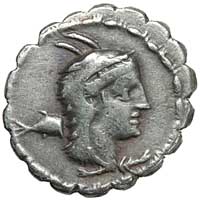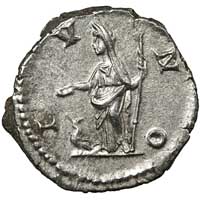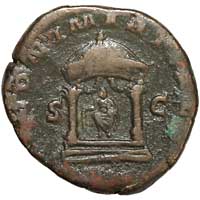| Home Page | Site Map | Useful Links | Email Me | Glossary | Next Page |
| ---------- The Sign Language of Roman Coins ---------- |
| Juno, Queen of the Gods |
| You can click on any coin image to see the full coin. |
 era was the jealous wife (and sister) of Zeus, an Olympian, and the Greek goddess of marriage. On the right is a Greek drachm from Chalkis with the head of Hera (probably) on the obverse. Her equivalent in the Roman pantheon was Juno. Like Hera, Juno was the wife of the chief god; in Rome, this was Jupiter. Together with her husband and his daughter Minerva, goddess of wisdom, she was worshipped in an elaborate temple on the Capitoline hill, known properly as "aedes Iovis Optimi Maximi Capitolini", the Capitoline temple of Jupiter the Best and Greatest. This "Capitoline triad" were Rome's most important deities.
era was the jealous wife (and sister) of Zeus, an Olympian, and the Greek goddess of marriage. On the right is a Greek drachm from Chalkis with the head of Hera (probably) on the obverse. Her equivalent in the Roman pantheon was Juno. Like Hera, Juno was the wife of the chief god; in Rome, this was Jupiter. Together with her husband and his daughter Minerva, goddess of wisdom, she was worshipped in an elaborate temple on the Capitoline hill, known properly as "aedes Iovis Optimi Maximi Capitolini", the Capitoline temple of Jupiter the Best and Greatest. This "Capitoline triad" were Rome's most important deities.
Juno had other aspects and other temples in Rome. For example, Juno Regina, with a temple on the Aventine, had been evoked from Veii back in 396 BCE when Rome first began to expand. This "evocation" was a ritual designed to bring across to the Roman side a deity belonging to an enemy. Quite a few deities who became important in Rome had originally been evoked in this way, including Venus of Eryx in Sicily, and the Magna Mater, Cybele, who were both brought into the centre of Rome during the second Punic War (with Carthage), 218 to 201 BCE. The Carthaginians appear to have identified the Venus of Eryx with their goddess Astarte, which the Romans clearly did not; in fact, the Romans considered Astarte to be the equivalent of Juno, and she was evoked into Rome as the Juno of Carthage during the third and final Punic War, 149 to 146 BCE. The equivalence of these deities seems to have been very much a matter of opinion, or perhaps of political expedience. There is no evidence that the Juno of Carthage was given a temple in Rome.
 The obverse of a silver denarius of L. Thorius Balbus showing the head of Juno Sospita wearing a goatskin.
The obverse of a silver denarius of L. Thorius Balbus showing the head of Juno Sospita wearing a goatskin.
 n Republican coins, Juno was usually shown in the warlike form of Juno Sospita, meaning the preserver or defender. Republican Rome had a temple to her in a vegetable market near the Tiber known as the Forum Holitorium. Juno Sospita wore a goatskin, as shown on the Republican denarius of L. Papius, dating from 79 BCE, on the near right. The goatskin, complete with horns, has been drawn up over her head.
n Republican coins, Juno was usually shown in the warlike form of Juno Sospita, meaning the preserver or defender. Republican Rome had a temple to her in a vegetable market near the Tiber known as the Forum Holitorium. Juno Sospita wore a goatskin, as shown on the Republican denarius of L. Papius, dating from 79 BCE, on the near right. The goatskin, complete with horns, has been drawn up over her head.
The fishtail behind her head on the coin of L. Papius is not related to Juno, but to the group of coins to which this one belongs – an interesting series with more than 230 known varieties of symbol pairs. You can see many of them on this excellent L. Papius Varieties page on another site.
The same head is shown on the denarius of L. Thorius Balbus on the far right. With it are the initials I.S.M.R, standing for IVNO SOSPITA MAGNA REGINA (or a very similar phrase): Juno the Preserver, Great Queen. Juno Sospita was also known as Juno Lanuvinum, and was the main deity of Lanuvium, where this moneyer was born.
When shown full length, as on the denarius of L. Procilius L.f from 80 BCE on the left, Juno Sospita wields a spear and carries a shield shaped like a figure 8, an item from the depths of pre-Greek history. It is possible that her warlike aspect is derived partly from Minerva, who sometimes carried her father's goatskin shield.
On Imperial coins, Juno was most commonly shown holding a patera, a shallow dish used in sacrifices, with a peacock below. The sacramental dish is usually tilted and the peacock seems to be looking upwards, so it is probable that it is being fed from the dish. Juno was not the only deity shown on Roman coins feeding a sacred creature; see also Salus and her snake.
The peacock was sacred to both Hera and Juno. Whereas deceased emperors would be shown riding to heaven on Jupiter's eagle, empresses rode Juno's peacock. The denarius on the right is of Julia Domna from 209 CE, and shows Juno in her usual pose, holding her patera and a tall sceptre, her peacock at her feet, with the simple legend IVNO. Her sceptre may be meant as a hasta pura, a silver spear-shaft without a head. The hasta pura was awarded by the emperor to soldiers who had saved the life of a civilian, so would be appropriate for a protecter of the people.
 any coins were issued in this basic type, but with legends that varied according to the particular aspect that was desired to be invoked at the time. Here are some examples.
any coins were issued in this basic type, but with legends that varied according to the particular aspect that was desired to be invoked at the time. Here are some examples.
Juno's most important function was as the queen of the gods, and this was how she was worshipped in the temple on the Capitoline.
On the far right is a billon antoninianus of Salonina from 260-268 CE, with the legend IVNO REGINA, "Queen Juno"; on the near right, a silver denarius of Faustina Junior from 161-175 CE, whose legend, IVNONI REGINAE, means the coin is dedicated to Queen Juno.
Both of these coins retain the image of the sacred peacock.
Juno was still worshipped as the preserver in Imperial times, but without the ferocious aspect and the goatskin of Juno Sospita. It was now more a case of keeping things in her charge than of fierce defence.
On the far left is an antoninianus of Otacilia Severa dating from 245-247, with the legend IVNO CONSERVAT. This is an abbreviation of the wording on the denarius of Julia Mamaea on the near left, from 222-235 CE: IVNO CONSERVATRIX.
Although the type is mostly the same on these coins, there is a noticeable difference in the coin on the far left — there is no peacock. Juno is still holding out her patera, but there is nothing to feed. This pose usually means that the patera holds a libation to be poured, and expresses a general piety and obervance of religious duties. As one would not expecy Juno to be subservient to any deity, that is probably not the case this time.
 he coin on the far right is another of Julia Mamaea, and shows Juno in a seated posture holding out a flower in her right hand. The object in her left arm is a swaddled child. It looks a little thin and stiff to be a child, but the custom of swaddling was to wrap the child tightly so that it could not move, and only its face would be visible. Although, even knowing this, this one looks unrealistic. The legend on this coin is IVNO AVGVSTAE, "Juno of the empress." The flower is like that held by Spes, goddess of hope, and when Spes was used on coins she normally symbolised the hope engendered by a fresh initiative such as a new reign, or a new child.
he coin on the far right is another of Julia Mamaea, and shows Juno in a seated posture holding out a flower in her right hand. The object in her left arm is a swaddled child. It looks a little thin and stiff to be a child, but the custom of swaddling was to wrap the child tightly so that it could not move, and only its face would be visible. Although, even knowing this, this one looks unrealistic. The legend on this coin is IVNO AVGVSTAE, "Juno of the empress." The flower is like that held by Spes, goddess of hope, and when Spes was used on coins she normally symbolised the hope engendered by a fresh initiative such as a new reign, or a new child.
This must therefore be Juno Lucina, Juno as the goddess of childbirth and a safe delivery. On the near right, this is shown explicitly on a denarius of Lucilla, the daughter of Marcus Aurelius and wife of Lucius Verus, dating from from 166-169 CE. It has exactly the same image, but this time the legend is IVNONI LVCINAE, "dedicated to Juno Lucina." This Juno also appeared on coins of Faustina Junior, Crispina, and Julia Domna. Her flower of hope is for the wellbeing of a new child, and it was the custom for mothers giving birth to pray to her. She was particularly associated with childbirth in the Imperial family.
 nother aspect of Juno was Moneta, one who warns or foretells. She was said to have advised the Romans to undertake only just wars, and they would never be in want of money. And so Juno Moneta became the protector of the finances of Rome. Her temple was on the Arx, one of the twin summits of the Capitoline hill, and the Rome mint adjoined it. The word Moneta came to be used for the money itself, as well as the workshops in which it was made; several English "monetary" words derive from her name. On Roman coins, Moneta the goddess appears quite often, but without the prefixing word Juno, even though that must be implied.
nother aspect of Juno was Moneta, one who warns or foretells. She was said to have advised the Romans to undertake only just wars, and they would never be in want of money. And so Juno Moneta became the protector of the finances of Rome. Her temple was on the Arx, one of the twin summits of the Capitoline hill, and the Rome mint adjoined it. The word Moneta came to be used for the money itself, as well as the workshops in which it was made; several English "monetary" words derive from her name. On Roman coins, Moneta the goddess appears quite often, but without the prefixing word Juno, even though that must be implied.
Here are two examples: a silver denarius of Septimius Severus from 194 CE on the far left, and a billon follis of Diocletian from 302-303 CE. In both cases, Moneta stands holding a balance, indicating fair measure, and a cornucopia, indicating abundance. Severus' coin simply reads MONET AVG; Diocletian's lengthy legend reads SAC MON VRB AVGG ET CAESS NN – Sacred coinage of the city of our Augusti and Caesars. The city, of course, was Rome – this was always Urbs, "The" city, to the Romans, and still is to this day when the word is capitalised. The Augusti and Caesars are the Tetrarchy which ruled at that time. The coinage was sacred because it was overseen by Juno Moneta.
 his mysterious type, labelled IVNO MARTIALIS, The Martial Juno, appears on coins of Trebonianus Gallus and Volusian. The coin on the right is an antoninianus of Trebonianus Gallus, dating from 251-253 CE. Juno is shown enthroned, holding a transverse sceptre, and in her extended right hand she has some objects which have been variously described as corn ears, shears and scissors. In fact, if you look at a number of these coins, you will find some which are so unlike shears or scissors as to make that impossible; for example, some show three jagged objects drooping from Juno's hand.
his mysterious type, labelled IVNO MARTIALIS, The Martial Juno, appears on coins of Trebonianus Gallus and Volusian. The coin on the right is an antoninianus of Trebonianus Gallus, dating from 251-253 CE. Juno is shown enthroned, holding a transverse sceptre, and in her extended right hand she has some objects which have been variously described as corn ears, shears and scissors. In fact, if you look at a number of these coins, you will find some which are so unlike shears or scissors as to make that impossible; for example, some show three jagged objects drooping from Juno's hand.
I think that those which do not look very much like ears of grain are merely badly engraved, and that in fact grain is intended. It is possible that the engravers were just copying a pattern and did not really know what the objects were supposed to be. On the example shown here, the objects look like neither corn nor shears, and that is not for a lack of clarity on the coin, which is well struck (except for a shallowly-struck section along the leg) from a reverse die which has some wear, but which is undamaged.
Juno Martialis certainly seems to have been important for a while, even though she is obscure to us today. The sestertius of Trebonianus Gallus on the left, with the legend IVNONI MARTIALI, shows the same Juno in a small round temple or shrine decorated with garlands. She is carrying a globe, which usually indicates dominion over the universe, and again has corn ears in her right hand.
So, where was this pretty temple? The Dictionary of Roman Coins mentions a temple to Juno Martialis in the Forum, but doesn't give a source for this. It has also been conjectured that it was on the Campus Martius, the Field of Mars where the troops were trained and where there were already three temples to Juno; or the Campus Martialis, a small area at the foot of the Caelian hill. But in fact, apart from these coins and a few others of the same period, there is no evidence of such a temple, or even that a cult of Juno Martialis existed at all.
| ———————— Useful References ———————— |
These books provided some, but not all, of the information on this page. Thanks also to the contributors to the Forum Classical Numismatics Discussion Board, a group of people who are both helpful and knowledgeable.
A Dictionary of Roman Coins by Seth William Stevenson, F.S.A., C Roach Smith, F.S.A., and Frederic W. Madden, M.R.A.S. First published by George Bell and Sons, 1889. Reprinted by B A Seaby Ltd, London in 1964.
Religions of Rome: Volume 1, A History by Mary Beard, John North and Simon Price. Published by Cambridge University Press in 1998.
The Man in the Roman Street by Harold Mattingly, F.B.A. Published by the Numismatic Review, New York City in 1947.
Roman Coins and Their Values, Volume III by David R. Sear. Published by Spink, London, in 2005.
Rome – Its People, Life and Customs, by Ugo Enrico Paoli, translated from the Italian by R. D. Macnaghten. Hardback published by Longmans in 1963; paperback published by Bristol Classical Paperbacks in 1990. First published as Vita Romana in 1940.
These books are covered in a bit more detail on my page on coin reference books.
| The content of this page was last updated on 31 December 2012 |
| Home Page | Site Map | Useful Links | Email Me | Glossary | Next Page |













